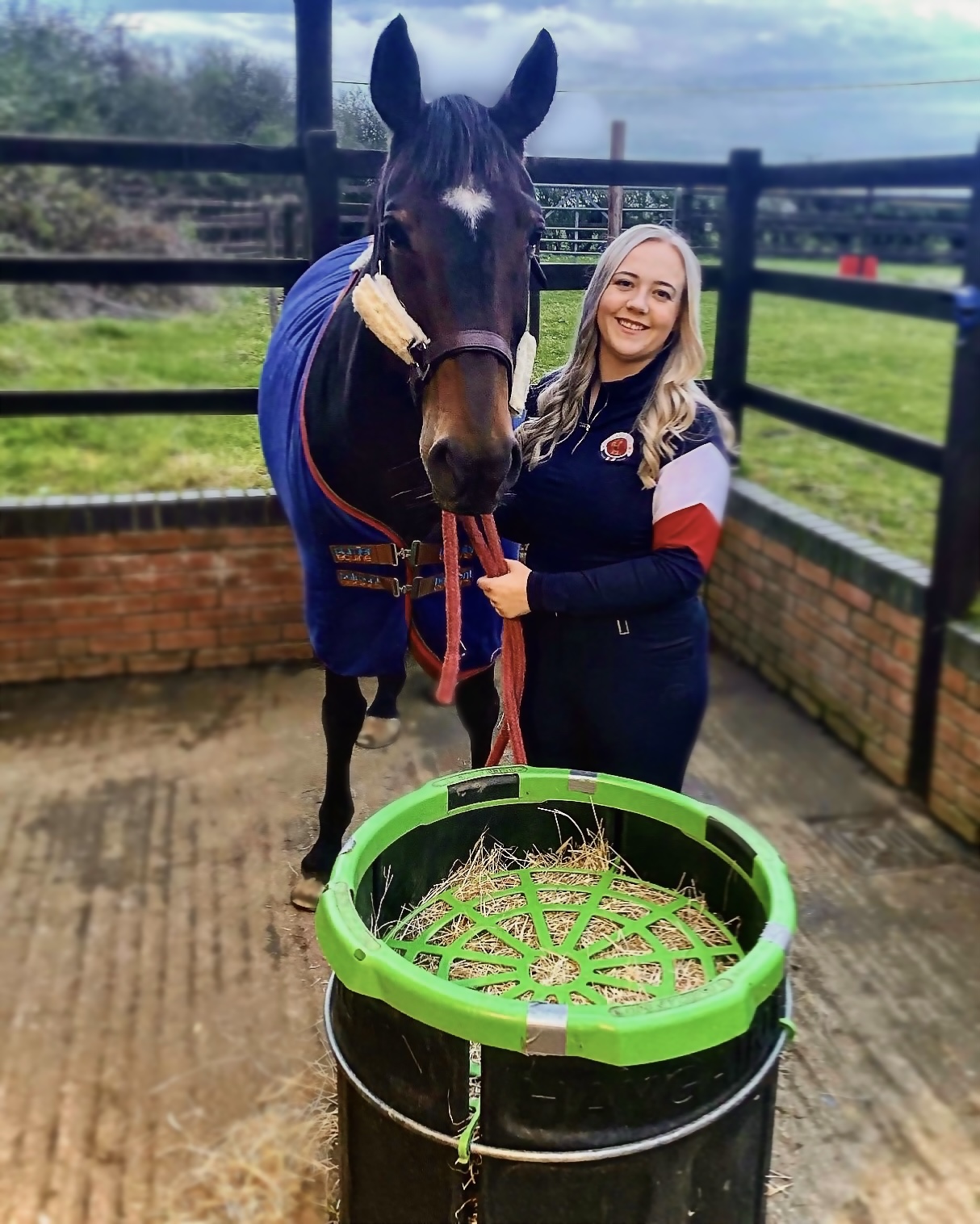Posted: 16th November 2022 | Back to news feed


Stephanie Duffin admits she didn’t initially use the Forager Slow Feeder that was sent along with Whinney.
“I thought ‘OK, whatever’…” says the veterinary nurse and amateur rider in Yorkshire. “I’d never heard of the Forager, so I just put it in a pile of stuff at the yard.”
The mare’s previous owners considered the Forager a critical piece of kit for Whinney because she was known to hoover all her hay at lightspeed.
Stephanie purchased Whinney as a steady mount to help get back in the saddle after an injury. The sweet 16-year-old was exactly that under saddle. When she wasn’t being ridden, however, she ate up every scrap of hay she could find. “We were going through hay like crazy,” Stephanie explains of Whinney’s expensive and potentially unhealthy habit.
Curbing Crazy Hay Consumption
So she took the Forager out of the box, assembled it on the stable floor and filled it up -- “not expecting it to work.” On returning a few hours later, Stephanie found Whinney still happily pulling stems through the Forager’s regulator grid. “It was madness!”
Whinney lives outside most of the day, so that’s where her Forager lives, too. Sand in its base helps it stay still as the mare nibbles away. The Slow Feeder has easily withstood Whinney knocking it around a bit with her bum in between meals. “It’s a really good design that’s lasting very well,” Stephanie reports.
As a veterinary nurse, Stephanie keeps her eye on the steady flow of horse heath products, all proclaiming their various benefits. “There are loads of things coming out these days, but with many of them I’m skeptical that it works as well as the manufacturers make out. The Forager is not one of them.”
The product promises Stephanie is so pleased to find true start with extending the amount of time Whinney spends enjoying her hay. The Forager’s regulator grid sits atop the hay in a durable, ventilated cylinder that holds 14 kg of forage. Openings in the grid enable Whinney to pull stems of hay through, mimicking the grazing behavior of horses eating in the wild.
Eating small bites of hay over several hours of the day allows forage to trickle through the horse’s digestive system. More time eating means more time chewing, and chewing produces saliva. Saliva is important to the digestive process and it buffers the lining of the stomach from naturally occurring acids.
Acids In Attack Mode
Horses produce up to nine gallons of gastric acid a day – some estimates say up to 16 gallons. In the wild, horses needed a constant supply of these acids to break down the forage they consumed while grazing. In modern life, however, horses that are fed on a schedule convenient to humans – typically just two or three times a day – wind up with acids but no forage to break down in the stomach. Instead, the acids can damage the stomach lining and cause ulcers.
Lack of forage in the digestive tract is even more harmful if the horse is exercising because the acid can splash into the especially vulnerable upper stomach.
The Forager reduces this risk by enabling the horse to have food in its stomach for more hours of the day. Compared to eating loose hay off the ground, Haygain research determines that horses spend more than twice the time eating the same quantity of hay out of a Haygain Forager.
Slowing horses down in their meals also helps good-doers who need to be on a restricted diet to control their weight.
Compared to another slow feeding method -- hay nets -- the Forager has the significant advantage of allowing the horse to eat with its head in a naturally lowered position. Again mimicking nature, the Forager allows a natural position for the neck, back and jaw, reducing stress on those joints.
Foragers are also great boredom busters. Stall weaving, cribbing and pawing are among the behaviors there’s less time for when more hours of the day are happily wiled away eating. Veterinarian consensus identifies four hours as the longest horses should go without access to forage. Going longer is bad for their bellies and can trigger food scarcity stress.
Healthy & Staying That Way
Whinney came to Stephanie with no underlying health problems. Her previous owners were so committed to her continued good health that they sent the Forager to Stephanie along with the mare. To them, it was as important as her halter and rugs.
Now that Whinney has proven the Forager’s worth, Stephanie is more than happy to have been proven wrong about her initial skepticism. The Forager even has a direct benefit for Stephanie: less hay wastage because the it keeps Whinney’s meals clean and contained. At today’s hay prices, that’s significant.
In short: “I am obsessed with the Forager!” the good nurse says.
For more information on the Haygain Forager Slow Feeder head to the website HERE.
The Equestrian Index newsfeed is compiled from articles submitted by advertising members and expresses the opinions of those members. Watsons Directories Ltd shall not be held liable for any inaccuracies or mis-statements therein.
